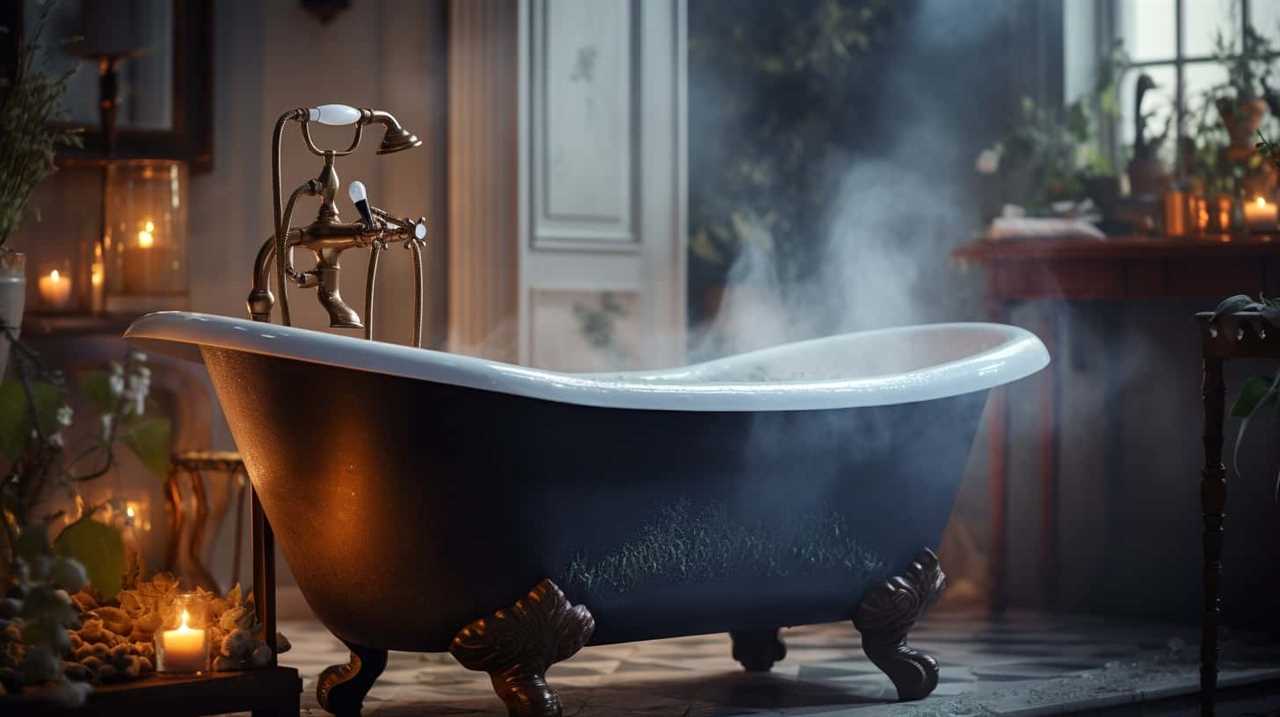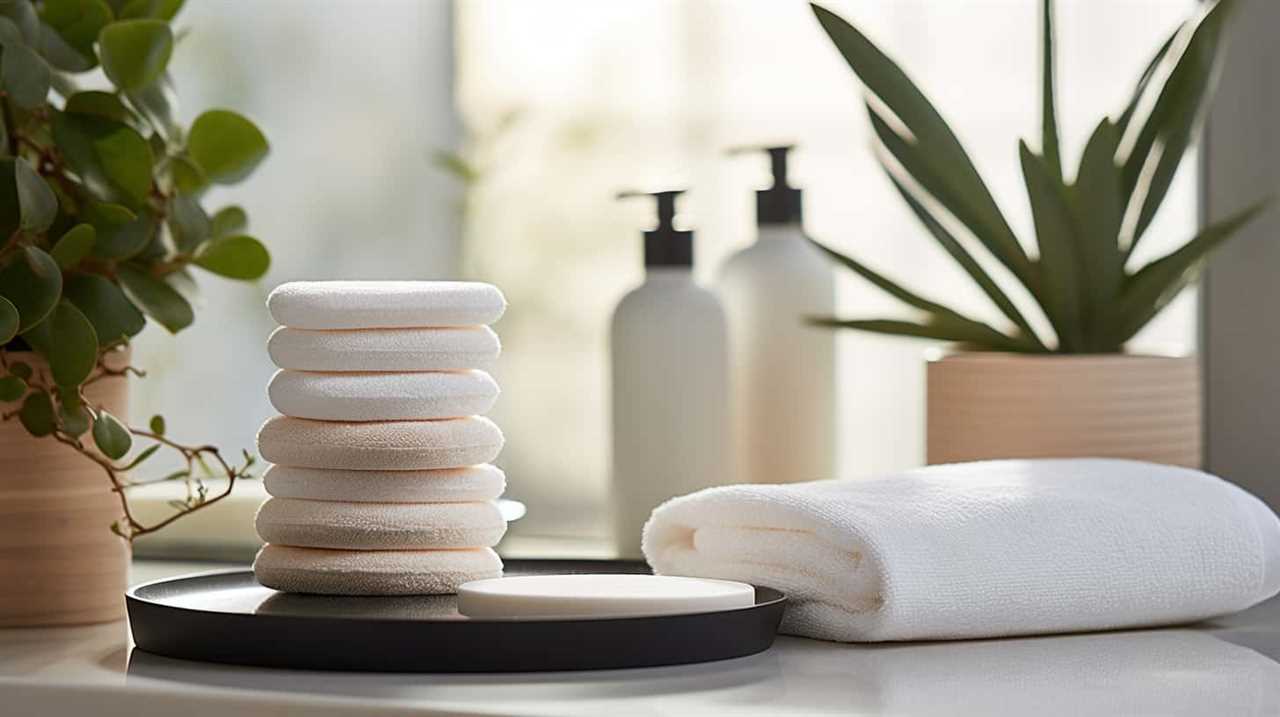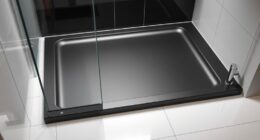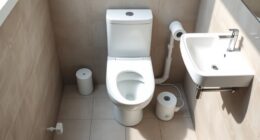Do bathroom exhaust fans consume a high amount of electricity?
Well, you might be surprised to learn that the answer is not as straightforward as it seems. In this article, we will delve into the average electricity consumption of bathroom exhaust fans, explore the factors that affect their energy usage, and provide tips to reduce electricity usage.
By the end, you’ll have a better understanding of how these fans compare to other appliances and the cost implications of running them.
Let’s dive in!

Key Takeaways
- Bathroom exhaust fans have a wattage range of 20 to 100 watts and consume 0.1 kilowatt-hours of electricity if running for 2 hours a day.
- The fan speed affects energy consumption, with higher speeds requiring more power and generating more noise.
- Regular cleaning and maintenance of the fan can improve energy efficiency by preventing dust and debris obstruction.
- Installing a timer, exploring alternative ventilation options, and minimizing reliance on exhaust fans can help reduce electricity usage.
Average Electricity Consumption of Bathroom Exhaust Fans
Bathroom exhaust fans consume an average amount of electricity. The wattage of a bathroom exhaust fan typically ranges from 20 to 100 watts, depending on the size and power of the fan. This wattage may seem low compared to other household appliances, but it can still have an impact on energy bills.
The fan’s wattage determines how much electricity it consumes per hour of operation. For example, a 50-watt fan running for 2 hours a day would consume 100 watt-hours or 0.1 kilowatt-hours of electricity. Over time, this can add up and contribute to increased energy costs.
It’s important to consider the wattage of bathroom exhaust fans when evaluating their impact on energy bills and to choose energy-efficient models that meet your ventilation needs.
Factors That Affect the Energy Usage of Bathroom Exhaust Fans
One factor that affects the energy usage of bathroom exhaust fans is the speed at which they operate. The faster the fan operates, the more energy it consumes. This is because higher speeds require more power to rotate the fan blades and move the air effectively.

It’s important to note that while higher speeds may result in better ventilation, they also lead to increased noise levels. Bathroom exhaust fans are designed to remove moisture and odors from the bathroom, but they can generate noise during operation.
Another factor that affects energy usage is the maintenance requirements for bathroom exhaust fans. Regular cleaning and maintenance of the fan blades and motor can help ensure optimal performance and energy efficiency. Additionally, keeping the fan free from dust and debris can prevent obstruction and reduce the need for the fan to work harder, thus saving energy.
Tips to Reduce Electricity Usage of Bathroom Exhaust Fans
How can we minimize the electricity usage of our bathroom exhaust fans?
Here are some energy saving techniques to consider:

- Install a timer: Set the fan to automatically turn off after a certain amount of time to avoid unnecessary usage.
- Clean the fan regularly: Dust and debris can accumulate on the fan blades, causing it to work harder and use more electricity. Regular cleaning can help maintain its efficiency.
- Consider alternative ventilation options: If possible, explore alternative ventilation options such as natural ventilation or heat recovery ventilation systems. These options can help reduce the reliance on exhaust fans and minimize electricity usage.
Comparing the Energy Efficiency of Bathroom Exhaust Fans to Other Appliances
When comparing the energy efficiency of bathroom exhaust fans to other appliances, we found that they use significantly less electricity.
In terms of energy consumption comparison, bathroom exhaust fans are designed to operate at low power levels, typically ranging from 10 to 50 watts. This is much lower than the energy consumption of other appliances like refrigerators, air conditioners, or water heaters.
The energy saving techniques employed in bathroom exhaust fans include the use of efficient motors, improved ventilation design, and the incorporation of features such as timers and motion sensors to minimize unnecessary usage.
Understanding the Cost Implications of Running a Bathroom Exhaust Fan
To further explore the topic, let’s delve into the financial implications of operating a bathroom exhaust fan. While bathroom exhaust fans play a crucial role in maintaining indoor air quality and preventing mold and mildew growth, it’s important to consider the cost of running them.

Here are some cost-effective measures and energy-saving options to keep in mind:
- Install a timer: By using a timer, you can set the exhaust fan to run for a specific period, reducing unnecessary energy consumption.
- Choose an energy-efficient model: Look for exhaust fans with the ENERGY STAR label, as they’re designed to use less energy while providing optimal performance.
- Regular maintenance: Keeping the fan clean and ensuring it operates smoothly can improve its efficiency and reduce electricity usage.
Frequently Asked Questions
Can a Bathroom Exhaust Fan Be Used as the Sole Source of Ventilation in a Bathroom?
A bathroom exhaust fan can be used as the sole source of ventilation in a bathroom, but it has its limitations. While it provides benefits such as removing moisture and odors, it may not be sufficient for larger bathrooms or areas with high humidity levels.
Are There Any Regulations or Guidelines Regarding the Energy Efficiency of Bathroom Exhaust Fans?
There are regulations and guidelines in place for improving the energy efficiency of bathroom exhaust fans. These measures help ensure that these fans use electricity wisely and contribute to overall energy conservation efforts.
How Long Should a Bathroom Exhaust Fan Be Run After Using the Shower or Bath?
To prevent mold growth in the bathroom, it is important to run the bathroom exhaust fan for a sufficient amount of time after using the shower or bath. Using a timer for the fan has many benefits.

Can a Bathroom Exhaust Fan Contribute to Indoor Air Pollution if Not Properly Maintained?
Bathroom exhaust fans, if not properly maintained, can contribute to indoor air pollution. Regular maintenance is essential to ensure efficient operation and prevent the buildup of dust, mold, and other contaminants.
Are There Any Alternative Methods to Remove Excess Moisture From a Bathroom Without Using an Exhaust Fan?
Are there alternative methods to remove excess moisture from a bathroom without using an exhaust fan? Natural ventilation is a viable solution. It provides fresh air circulation, reduces humidity, and eliminates the need for electricity consumption.
Conclusion
In conclusion, bathroom exhaust fans do use electricity, but their energy consumption can vary depending on factors such as the fan’s size, speed, and usage duration.
By implementing simple tips like cleaning the fan regularly and using it only when necessary, homeowners can reduce electricity usage and save on energy costs.

Comparing the energy efficiency of bathroom exhaust fans to other appliances can help individuals make informed decisions about their energy consumption.
Overall, understanding the cost implications of running a bathroom exhaust fan is essential for promoting energy efficiency.










